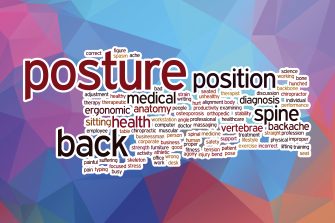Posture is Trending in Media, Health & Science
 By Steven Weiniger, DC
By Steven Weiniger, DC
“Sitting is the new smoking” is a trending message in the media, and research confirms it’s a truly pressing and growing problem. Chiropractors have always looked at posture, but have not communicated effectively to the world that we are the solution.
DCs can earn respect with patients as well as other health professionals, media and the public as the local posture specialist. However, in order to be a leader, others must follow. Which is why our message needs to be more than “come see me, I’m the best chiropractor in town.” We must communicate credible knowledge, modern original ideas and actionable ways for people to help themselves that are congruent with science, common-sense, their own interests – and congruent with chiropractic principles.
The posture focused clinician blends common-sense and scientific evidence to connect patients and biomechanics. It begins with a framework, one which must include a handful of principles that lets you and staff clearly communicate to everyone. Knowing that posture distortions can be distant from the area of complaint and/or initial injury is good, but quoting a recent paper in Neurosurgery: Spine that observed, “the spine functions as a global unit so that cervical alignment parameters influence, and are influenced by, parameters in the lower regions” builds credibility with MDs1. For patients, explain the 4th Posture Principle, Compensation: the body learns to move in the patterns you teach it.
Especially for aging boomers, the evidence that posture affects function is compelling. One 4.5 year study of people over 65 people found those with the greatest torso-pelvis forward lean had a 3.47 times greater likelihood of becoming dependent on help for activities of daily living, either at home or in a nursing facility.2 According to the authors, “Spinal posture changes with age, but accumulated evidence shows that good spinal posture is important for the aged to maintain independent lives.”
Another four year study of people over 60 found those with moderate forward head posture literally died sooner!3 People who needed more than a 1.7cm block under their head to bring it to level when lying supine were 44% more likely to die during this 4.2 year study. A possible reason is the strong association found between increased forward head posture and decreased respiratory muscle strength in people with neck pain4. In other words, pain, weak neck muscles and restricted cervical motion can affect respiratory function.
Self-help begins by promoting posture awareness. Take regular posture pictures of patients and compare changes over time. Posture assessment is visual palpation, a method of using your eyes instead of your fingers to see structural distortions and adaptations. By systematically observing how the head is balanced over the torso, the torso over the pelvis, and the pelvis over the legs, the trained eye can discern significant knowledge of bio-mechanic issues.
Self-help progresses by promoting focused exercise to retrain lost control of subtle motion. The granular positioning and stabilization that should be performed by deep core muscles is often neglected by standard rehab programs. Such motion control exercises (i.e. Yoga, Pilates, Tai-chi and the clinical StrongPosture® exercise protocols) have been shown to reduce low back pain, as well as improve posture and balance. For people in pain and when there’s lost segmental motion with deep adhesions, proper spinal adjustment opens the door to improved motion and function.
Our goal should be building the social perception of the value of chiropractic care. Posture is the key for chiropractors to communicate the connection between structure and function. In addition to helping patients, promoting posture as an important indicator of health is a public service strategy for DCs to make a unique contribution and earn respect as the posture specialist.
References
1 Cervical spine alignment, sagittal deformity, and clinical implications, A review. J Neurosurg Spine. 2013 Aug;19(2):141-59. doi: 10.3171/2013.4.SPINE12838.
2 Kamitani, K., Michikawa, T., Iwasawa, S., Eto, N., Tanaka, T., Takebayashi, T., & Nishiwaki, Y. (2013). Spinal posture in the sagittal plane is associated with future dependence in activities of daily living: A community-based cohort study of older adults in japan. J Gerontol A Biol Sci Med Sci, 68(7), 869-75. doi:10.1093/gerona/gls25
3 Kado, D. M., Huang, M. H., Karlamangla, A. S., Barrett-Connor, E., & Greendale, G. A. (2004). Hyperkyphotic posture predicts mortality in older community-dwelling men and women: A prospective study. Journal of the American Geriatrics Society, 52(10), 1662-7. doi:10.1111/j.1532-5415.2004.52458.
4 Kapreli, E., Vourazanis, E., Billis, E., Oldham, J. A., & Strimpakos, N. (2009). Respiratory dysfunction in chronic neck pain patients. A pilot study. Cephalalgia, 29(7), 701-10. doi:10.1111/j.1468-2982.2008.01787.
About the Author
Dr. Steven Weiniger will present Posture, Balance & Motion at the TCA 2016 Spring Conference in Knoxville. An internationally recognized posture expert, he has trained thousands of chiropractors and other wellness professionals to help people move well with StrongPosture® exercise protocols. Dr. Weiniger literally wrote the book on posture, Stand Taller Live Longer, and created the free PostureZone assessment app. His expertise on posture and health is featured extensively in media including NBC, ABC, CBS, FOX, Real Simple, SHAPE, and Women’s Health.